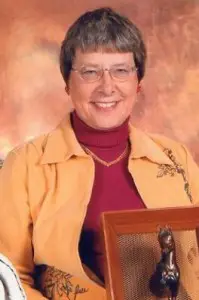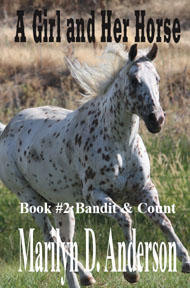 Marilyn D. Anderson is an American writer of fiction and nonfiction for both kids and adults. She was born a long time ago in Stillwater, Minnesota, which is way up north in the United States. But now she lives and writes much farther south in Indiana. In this interview, Marilyn talks about her books, her love for horses, reading and writing.
Marilyn D. Anderson is an American writer of fiction and nonfiction for both kids and adults. She was born a long time ago in Stillwater, Minnesota, which is way up north in the United States. But now she lives and writes much farther south in Indiana. In this interview, Marilyn talks about her books, her love for horses, reading and writing.
Voicu Mihnea Simandan: You have been a storywriter for many years. How has your writing evolved over time?
Marilyn D. Anderson: Actually I didn’t write my first book until I was 40 years old. At first I only wrote about horses and dogs. They are still my specialty, but in later years I’ve discovered I liked to write humor for early readers. Samples of these books are The Bubble Gum and Hot Fudge Pickles. I’ve also written a bunch of biographies for various publishers.
VMS: Where did the ideas for the “dog books” series and its initial “installment” Come Home Barkley (1996) come from?
MDA: Willowisp Publishing, who did my first 18 books, asked me to write a lost dog story. At the time I had a mixed breed dog that barked non-stop and got into lots of trouble. That dog was the model for Barkley.
VMS: As a “horse-aholic” (who also likes dogs), you have written quite a few books about horses, among which the A Girl with Her Horse series (2010). Why are horses so important for you?
MDA: That’s like asking a chocoholic why she likes chocolate. Horses are magnificent in their power and beauty, but they also give themselves to us as faithful servants. I feel as if I’ve sprouted wings when I ride one.
 VMS: You have recently published via iPulpFiction.com Winged Cobra (2011), a young adult story about, of course, “a beautiful horse.” Do you employ similar skills when writing books targeted for an older readership?
VMS: You have recently published via iPulpFiction.com Winged Cobra (2011), a young adult story about, of course, “a beautiful horse.” Do you employ similar skills when writing books targeted for an older readership?
MDA: Hmm. A story for young adults, not really my specialty, forces me to write something longer with a more complex plot. I’m also required to dive more deeply into characterization, which is hard for me.
VMS: Illustrations are a very important factor in any children’s books. Most of your books for children and humor are poignantly illustrated by various artists. What was your work relationship with the illustrators?
MDA: There isn’t any. In almost every case, I sent off the text, and it came back with pictures of my characters. I wasn’t always pleased with what the artist came up with. This is true of all children’s authors unless that author is extremely high profile.
VMS: You have started as a non-fiction author with The Horse Lover’s Handbook (1983) but have moved on to write children’s and YA books. How did you find the transition?
MDA: Actually I love writing nonfiction because I love doing research about things that interest me. Nonfiction is much easier to write because no one complains about motivation and believability. Also, the writer often has a signed contract for the book before she starts writing. That is hardly ever true in the case of fiction.
VMS: Some people believe that children no longer read and, with the availability of affordable e-readers, many believe that, sooner or later, children will no longer want to hold books in their hands. Please comment.
MDA: E-books are definitely taking over a big part of the market. However, a child whose parents read to him or her out of a real book at bedtime will always love the feel and the smell and the warmth of the printed page.
VMS: You have a well-maintained website. How important is it for writers these days to be “out there” on the Internet, interacting with their fans?
MDA: I’ve been dragged kicking and screaming into the Internet age. My friend (writer) Elaine Marie Alphin designed my web site, and Keith Shaw at iPulpFiction helps me maintain it. I have a new book coming out with Solstice Publishing in the near future, and they have strongly suggested that I start a blog. I let them go ahead, but I have no idea what I’m doing. All 4 Barkley books will shortly be available at fictionworks.com in e-book format. (Book 4 never got into print because Willowisp went out of business after I signed that contract.) It is absolutely essential to keep up with technology these days to get anywhere.
 VMS: You’ve recently been on a school visit. What were some of the highlights?
VMS: You’ve recently been on a school visit. What were some of the highlights?
MDA: I love school visits! I get to see what my readers are really like, I get to make them laugh, and their questions are a riot.
VMS: Do you still read children’s books and young adult fiction?
MDA: Yes! Not as many as I would like, but whenever I have a spare minute, I drag home a big stack of them.
VMS: What book are you working on right now?
MDA: At this moment I’m revising a play that I will direct for my church Christmas celebration. I’m also trying to get up the nerve to start a Civil War book set on the sea. Since I know nothing about ships, I have a lot of research to do before that can get off the ground.
VMS: What is your writing routine?
MDA: I try to devote every morning to some kind of writing and spend my afternoons living life. Most of my horse and dog books are based on things that really happened to me and my animals. I also teacher writing for the Institute of Children’s Literature, so some weeks I don’t get to write anything of my own.
VMS: What advice would you give to aspiring writers?
MDA: The place to start is NOT with a 50,000 word novel. Most people do better to start with short stories because they can gradually get a feel for how much dialogue and inner thoughts are needed, etc. It’s hard enough to keep all your plot lines straight with something 15,000 words long. Also, people who start with a novel have all their eggs in one basket. If that basket breaks, they get discouraged. It’s better to have lots of shorter projects out with magazine publishers. You’ll hit the mark with some so that the rejections letters don’t hurt so much. Also, be ready to revise and revise and revise.
VMS: Thank you for your time.
MDA: You’re very welcome. You ask great questions.
Voicu Mihnea Simandan
Bangkok, Thailand
October 30, 2011

This is a question for the MDA. What made you want to write Come Home, Barkley?